The Constitution of India, adopted on 26th January 1950, is the supreme law of the land. It lays down the framework for political principles, governance, and citizens’ rights. Drafted by the Constituent Assembly, the Indian Constitution is notable for its length, detail, and unique blend of features drawn from various global sources, tailored to Indian conditions.
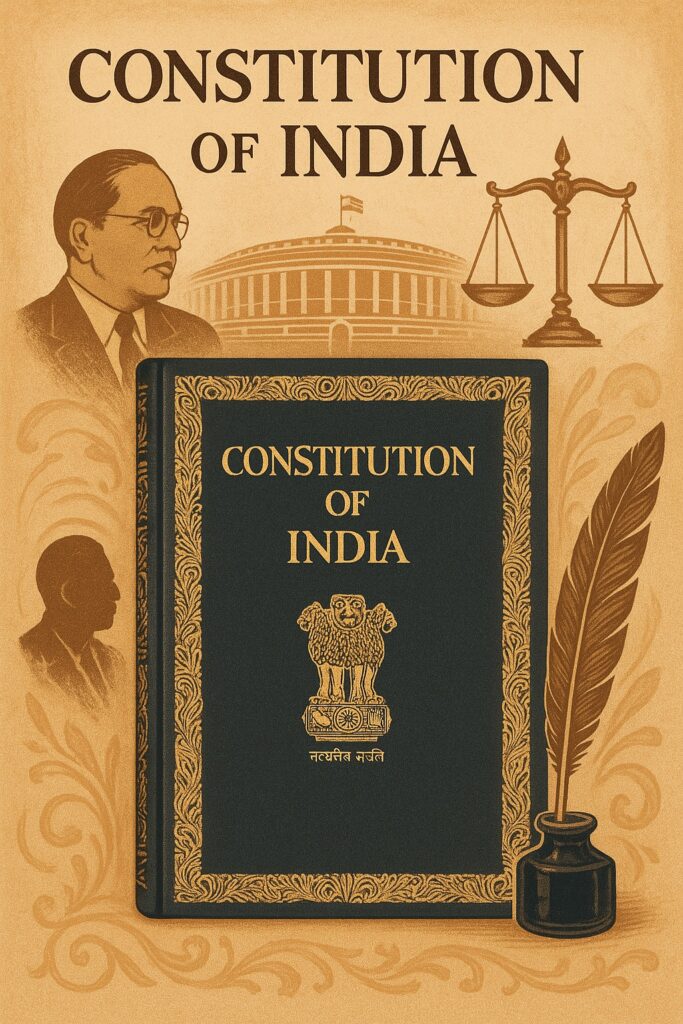
Table of Contents
Lengthiest Written Constitution
The Indian Constitution holds the distinction of being the longest written constitution in the world.
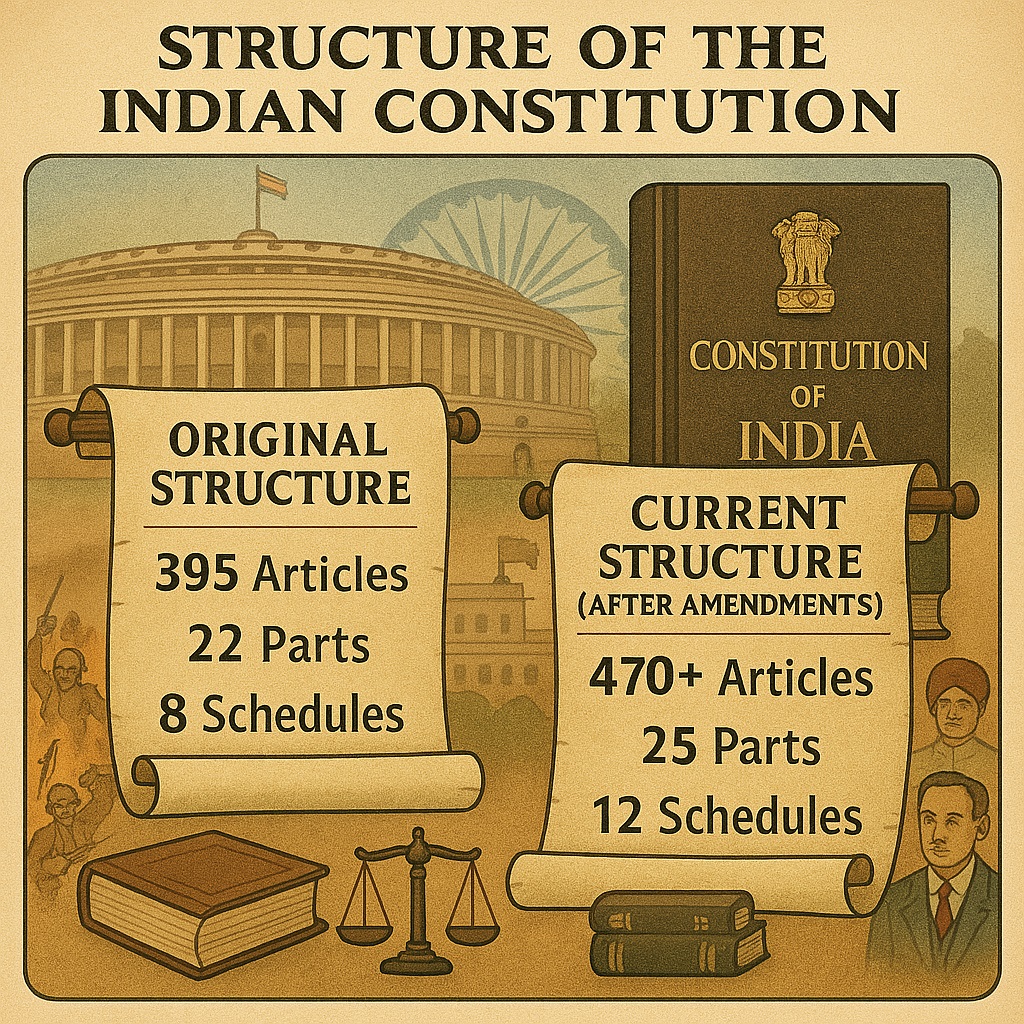
Reasons for its Length
- Diversity of India:
India is a multi-lingual, multi-religious, and multi-ethnic country. To ensure unity and justice for all, the Constitution includes elaborate provisions for social, cultural, and linguistic rights. - Detailed Centre-State Relations:
Unlike other federations, India’s Constitution specifies the powers and responsibilities of the Centre and the States in great detail (e.g., Union, State, and Concurrent Lists in the Seventh Schedule). - Inclusion of Legal and Administrative Provisions:
Provisions related to civil services, elections, emergency powers, official languages, tribal areas, etc., are included directly in the Constitution, rather than in separate laws. - Borrowed Features:
It has borrowed features from various constitutions of the world (like the British, American, Australian), requiring extensive detailing to integrate them into Indian conditions.
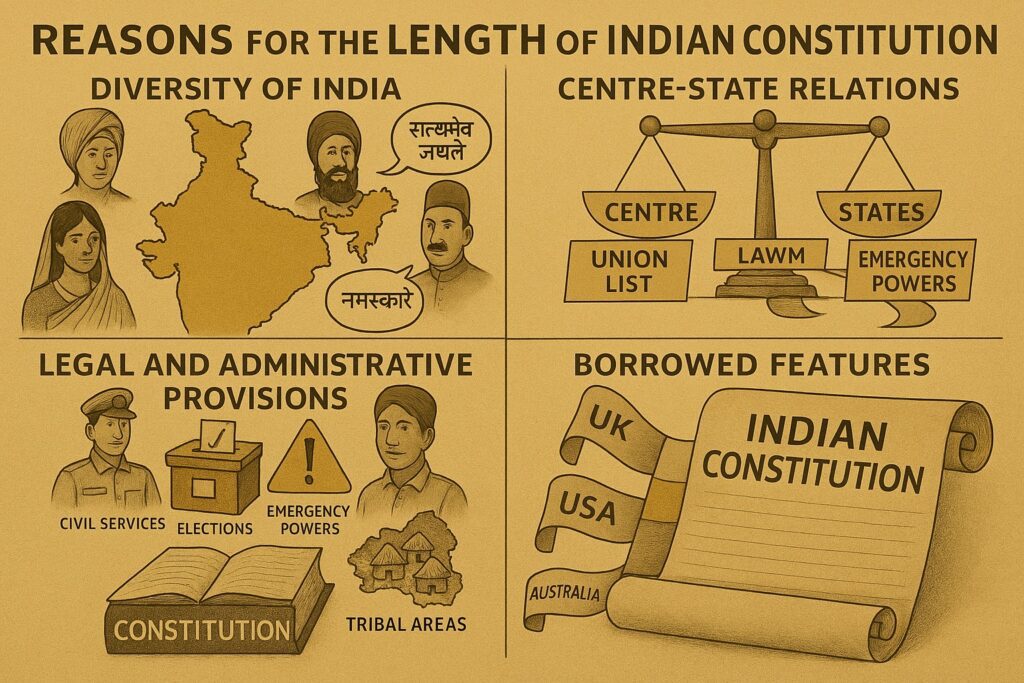
The Indian Constitution’s length reflects the framers’ intent to address the complex needs of a diverse and populous nation while ensuring clarity, flexibility, and unity in governance.
- The Indian Constitution is the longest written constitution in the world.
- It originally had 395 Articles, 22 Parts, and 8 Schedules (now over 470 Articles in 25 Parts and 12 Schedules).
- Its length is due to the diversity of India, detailed provisions for Centre-State relations, and the inclusion of administrative and legal guidelines.
Blend of Rigidity and Flexibility
One of the most unique features of the Indian Constitution is its blend of rigidity and flexibility. This means that while some parts of the Constitution are easy to amend, others are more difficult and require a complex process. This balanced approach helps the Constitution remain dynamic without compromising its fundamental principles.
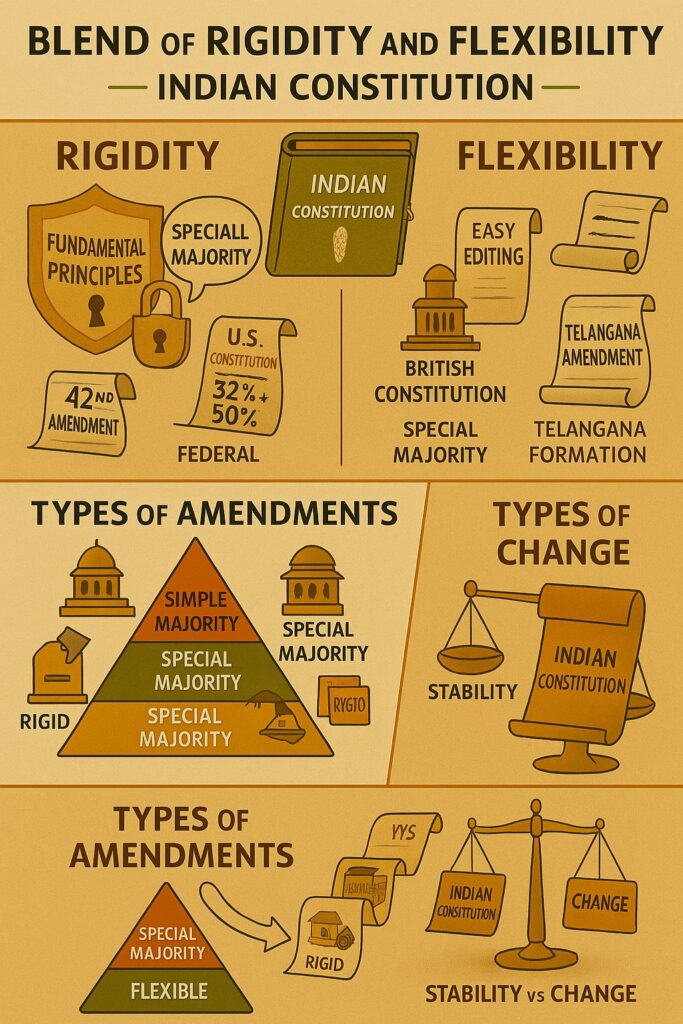
What Does It Mean?
- Rigidity: Like in the U.S. Constitution, some parts of the Indian Constitution are hard to change. They require a special procedure and wider agreement.
- Flexibility: Like in the British Constitution, some parts can be changed easily, by a simple majority in Parliament.
Types of Amendments (Article 368)
By Simple Majority (like passing an ordinary law)
-
- Used for minor changes (e.g., changing the names of states, or salaries of MPs).
- These amendments do not fall under Article 368.
- Example: Reorganization of states.
By Special Majority of Parliament
-
- Requires a 2/3 majority of members present and voting, and more than 50% of total strength of each House.
- Used for most constitutional amendments.
- Example: Amendment of Fundamental Rights or DPSPs.
By Special Majority + Ratification by Half the States
- For changes that affect the federal structure, such as:
- Election of the President,
- Powers of the Union and States,
- Representation of states in Parliament.
- These amendments need approval by at least 50% of state legislatures in addition to the special majority in Parliament.
Why Is This Blend Important?
- Flexibility allows the Constitution to adapt to new challenges and changing needs of society.
- Rigidity ensures that core values and federal balance are not easily altered for political convenience.
- It helps maintain a balance between change and stability.
Federal System with Unitary Bias
India is described as having a federal system, but it is not a typical federation like the United States. Instead, the Indian Constitution creates a federation with a strong central government, often referred to as a “federal system with a unitary bias.”
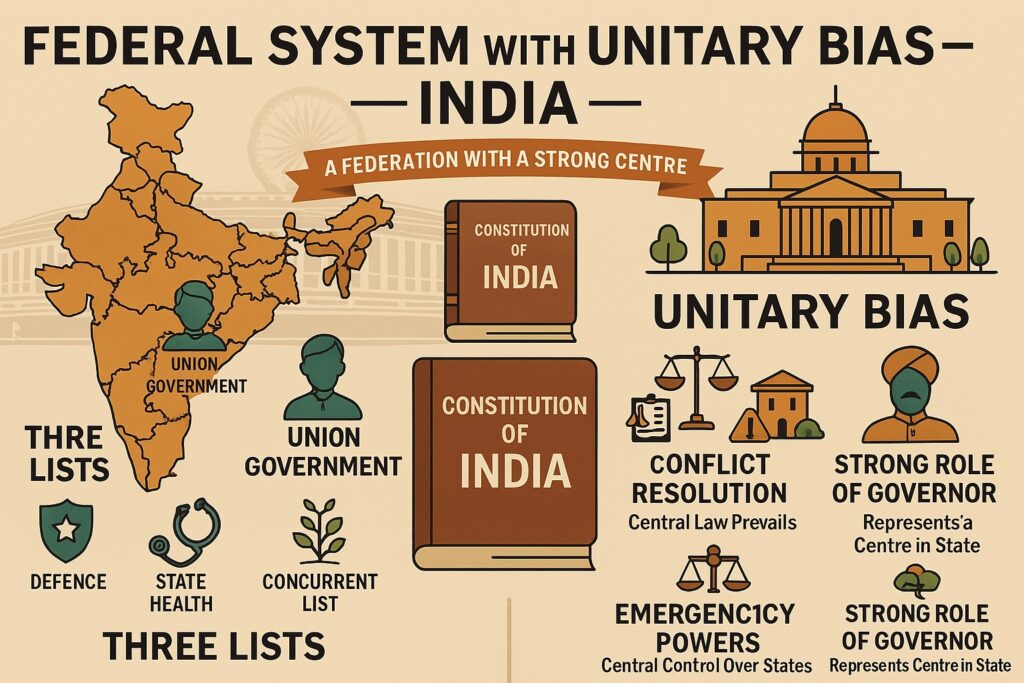
What is Federalism?
Federalism means that power is divided between a central authority and various state governments, with each level being independent in its own sphere. In a pure federation, both levels are equal and sovereign in their areas of jurisdiction.
How India’s Federalism Works
India’s Constitution divides powers between the Centre and States using the Three Lists in the Seventh Schedule:
- Union List – Subjects under exclusive control of the Central Government (e.g., defence, foreign affairs, railways).
- State List – Subjects under exclusive control of State Governments (e.g., police, public health, agriculture).
- Concurrent List – Subjects where both Centre and States can make laws (e.g., education, forests, marriage laws). If there’s a conflict, the Central law prevails.
Unitary Bias – When and How?
While India functions as a federation under normal conditions, the Constitution gives more power to the Centre in specific situations, showing a unitary bias:
1. During Emergency
- In National Emergency (Article 352), the Centre can legislate on State List subjects.
- The President can override state governments.
- Federal structure becomes unitary – all powers shift to the Centre.
2. President’s Rule (Article 356)
- If a state government fails to function as per the Constitution, President’s Rule can be imposed.
- The Governor administers the state on behalf of the Centre.
3. Financial Control
- The Centre controls major sources of revenue and allocates funds to states.
- This creates a financial dependence of states on the Centre.
4. Single Constitution and Citizenship
- Unlike many federations, India has only one Constitution for the entire country (except for some special cases like J&K earlier).
- Also, there is single citizenship, promoting national unity.
India’s federal system ensures state autonomy, but the Constitution gives the Centre more authority, especially in matters of national importance or crisis. This “federal with unitary bias” design helps maintain unity, integrity, and efficient governance in a diverse and large country like India.
Parliamentary Form of Government
India follows the Parliamentary form of government, also known as the Westminster model, inspired by the British system. In this system, the executive is drawn from and accountable to the legislature, ensuring responsible and democratic governance.
- Dual Executive: India has two types of executives. The President is the nominal or constitutional head, while the Prime Minister is the real executive, who leads the government and exercises actual powers.
- Collective Responsibility: The Council of Ministers, headed by the Prime Minister, is collectively responsible to the Lok Sabha. If the Lok Sabha passes a vote of no confidence, the entire ministry is required to resign.
- Leadership of the Prime Minister: The Prime Minister is the leader of the majority party in the Lok Sabha. He or she acts as the chief advisor to the President and coordinates the work of the Cabinet, playing a central role in both policy and administration.
- Fusion of Powers: Unlike in a presidential system where powers are separated, in the parliamentary system, the executive and legislature are interlinked. Most ministers are also members of Parliament, creating close cooperation between the two branches.
This system ensures executive accountability, allows for flexibility and quick decision-making, and reflects the democratic will of the people through their elected representatives. However, it can sometimes lead to political instability, especially during coalition governments.
Fundamental Rights
The Fundamental Rights are a set of rights guaranteed by the Constitution of India to all its citizens. These rights are enshrined in Part III of the Constitution (Articles 12 to 35) and are considered essential for the overall development of individuals and the preservation of democracy. They are justiciable, meaning that if these rights are violated, a person can approach the High Courts or the Supreme Court for protection.
- Right to Equality (Articles 14–18): Guarantees equality before the law and equal protection of the laws. It prohibits discrimination based on religion, race, caste, sex, or place of birth. It also abolishes untouchability and titles (except academic or military titles).
- Right to Freedom (Articles 19–22): Includes several freedoms such as:
- Freedom of speech and expression
- Freedom of assembly
- Freedom to form associations or unions
- Freedom to move freely throughout the territory of India
- Freedom to reside and settle in any part of India
- Freedom to practice any profession or carry on any occupation
It also includes protection in respect of conviction for offences, protection of life and personal liberty, and safeguards against arbitrary arrest and detention.
- Right against Exploitation (Articles 23–24): Prohibits human trafficking, forced labour, and child labour. It ensures that no person can be exploited or made to work under inhuman conditions.
- Right to Freedom of Religion (Articles 25–28): Guarantees the freedom of conscience and the right to freely profess, practice, and propagate any religion. It also ensures that no religious instruction is imposed in government-funded institutions.
- Cultural and Educational Rights (Articles 29–30): Protects the rights of minorities to preserve their culture, language, and script. It allows them to establish and administer their own educational institutions.
- Right to Constitutional Remedies (Article 32): Described by Dr. B.R. Ambedkar as the “heart and soul of the Constitution”, this right empowers citizens to move the Supreme Court for the enforcement of Fundamental Rights. The courts can issue writs such as Habeas Corpus, Mandamus, Prohibition, Certiorari, and Quo Warranto.
These rights form the foundation of Indian democracy. While they are not absolute and can be restricted under reasonable circumstances (like national security or public order), they provide a framework for dignity, liberty, and justice in the country. Fundamental Rights are essential for ensuring equality, freedom, and protection for every citizen of India.
Directive Principles of State Policy (DPSPs)
The Directive Principles of State Policy (DPSPs) are guidelines or principles enshrined in Part IV of the Indian Constitution (Articles 36 to 51). These principles are not legally enforceable in a court of law, but they are fundamental in the governance of the country. They aim to create a welfare state and guide the government in making laws and policies that ensure social, economic, and political justice for all citizens.
-
Not Justiciable: Unlike Fundamental Rights, DPSPs are not enforceable by the courts. However, they are considered moral and political obligations of the state.
-
Inspired by the Irish Constitution: The concept of DPSPs is borrowed from the Constitution of Ireland, and reflects the ideals of social justice, economic welfare, and democratic governance.
-
Aims to Establish a Welfare State: DPSPs guide the government to work for the common good, reduce inequality, and promote the well-being of all sections of society, especially the poor and disadvantaged.
Categories of DPSPs
-
Socialistic Principles:
-
Promote the welfare of the people by securing a just social order.
-
Provide adequate means of livelihood for all citizens.
-
Prevent concentration of wealth and resources in a few hands.
-
Ensure equal pay for equal work for both men and women.
-
Protect the health and strength of workers and children.
-
-
Gandhian Principles:
-
Promote cottage industries in rural areas.
-
Organize village panchayats.
-
Prohibit the consumption of intoxicating drinks and drugs.
-
Promote the educational and economic interests of Scheduled Castes, Scheduled Tribes, and other weaker sections.
-
Improve public health and promote animal husbandry.
-
-
Liberal-Intellectual Principles:
-
Secure uniform civil code for all citizens.
-
Provide opportunities for free and compulsory education for children.
-
Protect the environment and national heritage.
-
Promote international peace and security.
-
Separate the judiciary from the executive in public services.
-
Importance of DPSPs
-
They act as a moral compass for the government to frame policies aimed at public welfare.
-
Many progressive laws and reforms in India have been inspired by DPSPs, such as:
-
Mid-Day Meal Scheme
-
Right to Education Act
-
MGNREGA (employment guarantee)
-
Environmental laws
-
Though they are non-justiciable, DPSPs play a vital role in nation-building and in guiding India toward the vision of justice, equality, and dignity as promised in the Preamble of the Constitution.
Secular State
India is a secular state, which means that the government does not favor or discriminate against any religion. The word “secular” was officially added to the Preamble of the Constitution by the 42nd Amendment Act of 1976, but the principle of secularism was already embedded in the spirit of the Constitution.
-
Equal Respect for All Religions: In India, all religions are treated with equal respect and dignity. The state has no official religion, and no religious group is given preferential treatment.
-
Freedom of Religion (Articles 25–28): The Constitution guarantees every citizen the right to freely profess, practice, and propagate any religion. This right is subject to public order, morality, and health, ensuring that religious freedom does not harm others or disrupt peace.
-
No Religious Instruction in State-Run Institutions: Article 28 states that no religious instruction shall be imparted in government-funded educational institutions, ensuring religious neutrality in public education.
-
No Discrimination Based on Religion: The state cannot discriminate in matters of employment, access to public places, or education based on religion. All citizens are equal before the law, regardless of their faith.
-
Right to Manage Religious Affairs: Every religious denomination has the right to manage its own religious affairs, including the establishment and maintenance of institutions, under Article 26.
India’s secularism is positive and inclusive. It allows individuals and communities to practice their religion freely, while also ensuring that the state remains neutral and fair to all. This helps maintain religious harmony and unity in a diverse society like India.
Single Citizenship
India follows the principle of Single Citizenship, which means that every Indian citizen is a citizen of India only, regardless of the state or union territory they belong to. This concept is borrowed from the British system and is a key feature of the Indian Constitution.
-
Uniform Citizenship for All: There is no separate citizenship for individual states. All Indians, whether from Kerala or Kashmir, Maharashtra or Manipur, share the same legal identity as Indian citizens.
-
Mentioned in the Constitution: Article 5 to 11 in Part II of the Constitution deal with citizenship at the commencement of the Constitution, but nowhere does it provide for state-level citizenship.
-
Promotes National Unity: Single citizenship promotes the feeling of national unity and integrity, as all Indians enjoy the same fundamental rights and duties across the country.
-
Equal Rights Across India: A citizen can move freely, settle, work, and own property in any part of India without requiring permission or facing restrictions based on state boundaries.
-
Different from Some Other Federations: In countries like the USA, there is dual citizenship—one at the national level and one at the state level. India does not follow this model to avoid regionalism and fragmentation.
In conclusion, the idea of Single Citizenship helps in building a strong sense of national identity and ensures uniform rights and responsibilities for all citizens, which is essential in a diverse and federal country like India.
Unlike federal systems like the USA, India provides single citizenship to all its citizens, regardless of the state they belong to.
Independent Judiciary
Universal Adult Franchise
Universal Adult Franchise means that every adult citizen of a country has the right to vote in elections, without discrimination based on caste, gender, religion, education, wealth, or social status. In India, this is a fundamental feature of democracy and reflects the principle of political equality.
-
Guaranteed by the Constitution: Article 326 of the Indian Constitution provides for universal adult suffrage. It states that every citizen who is 18 years or older is eligible to vote in elections to the Lok Sabha and State Legislative Assemblies, provided they are not disqualified by law.
-
Adopted Since Independence: India granted universal adult franchise from the very beginning of its democratic journey in 1950, unlike many Western democracies that extended voting rights gradually.
-
No Discrimination: There is no discrimination based on caste, class, religion, gender, or education. Every adult citizen has one vote and one value, making the electoral process fair and equal.
-
Age Criteria: Initially, the voting age was 21 years, but it was lowered to 18 years by the 61st Constitutional Amendment Act, 1988, to allow greater participation of youth in the democratic process.
-
Empowers the People: Universal adult franchise gives every citizen a voice in choosing their representatives and shaping the government. It ensures that the government remains accountable and responsive to the people.
-
Strengthens Democracy: This principle plays a vital role in making India the largest democracy in the world, by encouraging inclusive governance and ensuring that power lies with the people.
In conclusion, universal adult franchise is the foundation of Indian democracy, promoting equality, participation, and political empowerment for all citizens, regardless of their background.
Emergency Provisions
The Emergency Provisions in the Indian Constitution are special powers given to the President of India to deal with unusual or crisis situations that threaten the security, unity, or financial stability of the country. These are mentioned in Part XVIII (Articles 352 to 360) of the Constitution. During an emergency, the normal distribution of powers between the Centre and States changes, giving more authority to the Central Government.
Types of Emergencies in India
- National Emergency (Article 352)
This is declared when there is a threat to the security of India due to war, external aggression, or armed rebellion.- Can be declared for the whole country or a part of it.
- The Centre gains power to legislate on all state subjects.
- Fundamental Rights under Article 19 are suspended.
- The Lok Sabha’s term can be extended by one year at a time during the emergency.
- Examples: 1962 (India-China war), 1971 (India-Pakistan war), and 1975 (declared due to internal disturbance).
- President’s Rule or State Emergency (Article 356)
This is imposed when the state government fails to function according to constitutional provisions (often called “constitutional breakdown”).- The President takes over the state’s administration.
- The State Legislative Assembly is either suspended or dissolved.
- The rule is usually imposed for six months and can be extended up to three years with parliamentary approval.
- It has been used many times in different states.
- Financial Emergency (Article 360)
Declared when there is a threat to the financial stability or credit of India or any part of it.- The Centre can direct states on how to use their financial resources.
- The salaries of government officials, including judges, can be reduced.
- No Financial Emergency has ever been declared in India till date.
Importance and Impact
- Emergency provisions help the government act swiftly in times of crisis.
- However, misuse of these powers (especially the 1975 Emergency) has led to serious concerns about civil liberties and democratic values.
- As a result, the 44th Amendment Act, 1978, introduced safeguards:
- Made it harder to declare a National Emergency.
- Protected some Fundamental Rights from suspension.
In conclusion, the Emergency Provisions are powerful tools for national protection, but they must be used carefully and constitutionally, as they can override democratic freedoms if misused.
Special Provisions for Certain States
Here is a clear explanation of Special Provisions for Certain States in the Indian Constitution using paragraphs and bullet points:
The Indian Constitution provides special provisions for certain states due to their unique historical, cultural, geographical, and political conditions. These provisions aim to preserve local identities, promote development, and address administrative challenges. They are mainly found in Article 371 to Article 371J in Part XXI of the Constitution.
Why Special Provisions?
India is a country of great diversity, and some states have:
- Distinct tribal populations and customs
- Border-sensitive locations
- Backward economic or social conditions
- Special historical agreements (like the merger of princely states or regional movements)
Key Examples of Special Provisions
- Article 370 (Jammu & Kashmir)
Earlier granted special autonomy to the state.- Separate Constitution and flag
- Limited applicability of Central laws
- Abrogated in August 2019, making J&K a Union Territory.
- Article 371 (Maharashtra and Gujarat)
- Special responsibility of the Governor for the development of backward regions and the equitable distribution of funds.
- Article 371A (Nagaland)
- Laws related to religious or social practices, Naga customary law, and land ownership cannot apply unless approved by the State Assembly.
- Article 371B (Assam)
- Provides for a special committee in the State Assembly to ensure the interests of tribal areas are protected.
- Article 371C (Manipur)
- Similar to Assam; ensures the development of hill areas and the safeguard of tribal interests.
- Article 371D & 371E (Andhra Pradesh and Telangana)
- Guarantees equal opportunities in public employment and education.
- Allows the President to establish Central Universities in these states.
- Article 371F (Sikkim)
- Protects the rights and privileges of Sikkimese people after the merger with India in 1975.
- Recognizes existing laws and traditions.
- Article 371G (Mizoram)
- Protects customary laws, land ownership, and religious practices.
- Central laws on these matters require state approval.
- Article 371H (Arunachal Pradesh)
- Special powers to the Governor, especially concerning law and order.
- Article 371I (Goa)
- Provides for a Legislative Assembly for Goa (no special privileges).
- Article 371J (Karnataka – Hyderabad-Karnataka region)
- Ensures reservation in education and jobs for the people of the backward regions.
Importance
- These provisions help in protecting regional diversity, tribal customs, and local development.
- They aim to reduce regional imbalances and promote inclusive growth.
In conclusion, the special provisions under the Indian Constitution show the flexibility of Indian federalism and the respect for diversity and local autonomy, while maintaining national unity.
Promotion of Unity in Diversity
Unity in Diversity is one of the most celebrated ideals of India’s national identity. It reflects how people of different languages, religions, cultures, and traditions live together peacefully within a single nation. The Indian Constitution plays a crucial role in promoting and protecting this unity, while also respecting the rich diversity of its people.
What Does Unity in Diversity Mean?
It means that despite having:
-
Multiple religions (Hinduism, Islam, Christianity, Sikhism, etc.)
-
Over 120 languages and 22 official languages
-
Numerous castes, tribes, and ethnic groups
-
Varied cultures and lifestyles
India still functions as one democratic nation with equal rights and common citizenship.
How the Constitution Promotes Unity in Diversity
-
Single Citizenship: Every Indian is a citizen of the country, not of any particular state. This encourages a common national identity.
-
Fundamental Rights (Part III): Rights such as equality before law, freedom of religion, and cultural rights ensure that people from different backgrounds live together with mutual respect and equal treatment.
-
Secularism: The Constitution ensures freedom of religion and equal respect for all faiths, promoting harmony among different religious groups.
-
Federal Structure with a Strong Centre: While states enjoy autonomy, the Central Government ensures national unity, especially in times of crisis.
-
Promotion of Minority and Cultural Rights (Articles 29 and 30): These articles protect the languages, cultures, and educational rights of minorities, ensuring that diversity is respected and preserved.
-
Directive Principles (Part IV): They guide the state to promote the welfare of all citizens and reduce inequality, thereby strengthening social harmony.
-
Recognition of Multiple Languages (8th Schedule): The Constitution recognizes 22 official languages, encouraging linguistic diversity while maintaining national communication through Hindi and English.
-
Equal Representation: People from different regions and backgrounds are represented in the Parliament, helping every section of society participate in governance.
Conclusion
India’s Constitution not only protects the diversity of its people but also unites them under a shared democratic framework. By ensuring equality, justice, freedom, and cultural rights, the Constitution promotes Unity in Diversity, which is the strength and soul of the Indian nation.
Read: Polity Notes